Students must practice these Maths 1A Important Questions TS Inter 1st Year Maths 1A Inverse Trigonometric Functions Important Questions to help strengthen their preparations for exams.
TS Inter 1st Year Maths 1A Inverse Trigonometric Functions Important Questions
Question 1.
Prove that sin-1\(\frac{4}{5}\) + sin-1\(\frac{7}{25}\) = sin-1\(\frac{117}{125}\). [Mar. ’16(TS), ’13]
Answer:
Let sin-1\(\frac{4}{5}\) = A and sin-1\(\frac{7}{25}\) = B
Then sin A = \(\frac{4}{5}\) and sin B = \(\frac{7}{25}\)
∴ cos A = \(\frac{3}{5}\) and cos B = \(\frac{24}{25}\)
∴ sin (A + B) = sin A cos B + cos A sin B
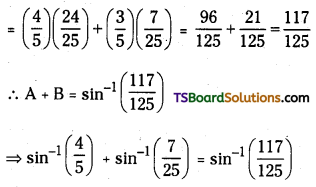
Question 2.
Prove that sin-1\(\frac{3}{5}\) + sin-1\(\frac{8}{17}\) = cos-1\(\frac{36}{85}\). [Mar. ’19(TS); May ’12, ’09]
Answer:
Let sin-1\(\left(\frac{3}{5}\right)\)
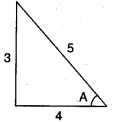
sin A = \(\frac{3}{5}\);
cot A = \(\frac{4}{5}\)
Let sin-1\(\left(\frac{8}{17}\right)\) = B
sin B = \(\frac{8}{17}\);
cos B = \(\frac{15}{17}\)
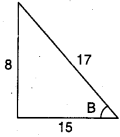
Let cos-1\(\left(\frac{36}{85}\right)\) = C
cos C = \(\frac{36}{85}\)
∴ A + B = C
cos (A + B) = cos C
L.H.S = cos (A + B) = cos A cos B – sin A sin B
= \(\frac{4}{5} \cdot \frac{15}{17}-\frac{3}{5} \cdot \frac{8}{17}=\frac{60}{85}-\frac{24}{85}=\frac{36}{85}\)
= RHS
∴ sin-1\(\left(\frac{3}{5}\right)\) + sin-1\(\left(\frac{8}{17}\right)\) = cos-1\(\left(\frac{36}{85}\right)\)
![]()
Question 3.
Prove that cos-1\(\left(\frac{4}{5}\right)\) + sin-1\(\left(\frac{3}{\sqrt{34}}\right)\) = tan-1\(\left(\frac{27}{11}\right)\). [May ’13]
Answer:
Let cos-1\(\left(\frac{4}{5}\right)\) = A and sin-1\(\left(\frac{3}{\sqrt{34}}\right)\) = B
Then cos A = \(\frac{4}{5}\) and
sin B = \(\left(\frac{3}{\sqrt{34}}\right)\)
tan A = \(\sqrt{\sec ^2 A-1}=\sqrt{\frac{25}{16}-1}\)
= \(\frac{3}{4}\)
and
cos2B
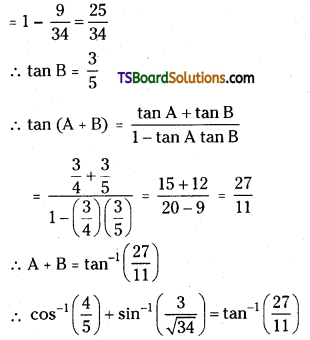
Question 4.
Find the value of
tan \(\left(\sin ^{-1}\left(\frac{3}{5}\right)+\cos ^{-1}\left(\frac{5}{\sqrt{34}}\right)\right)\). [Mar. ’13]
Answer:
Let sin-1\(\left(\frac{3}{5}\right)\) = A and
cos-1\(\left(\frac{5}{\sqrt{34}}\right)\)
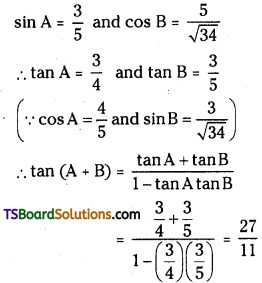
Question 5.
Find the value of cos(sin-1\(\frac{3}{5}\) + sin-1\(\frac{5}{13}\)).
Answer:
Let sin-1\(\left(\frac{3}{5}\right)\) = A and sin-1\(\left(\frac{5}{13}\right)\) = B then
sin A = \(\frac{3}{5}\) and sin B = \(\frac{5}{13}\)
∴ cos A = \(\frac{4}{5}\) and
cos B = \(\frac{12}{13}\)
∴ cos (A + B) = cos A cos B – sin A sin B
= \(\left(\frac{4}{5}\right)\left(\frac{12}{13}\right)-\left(\frac{3}{5}\right)\left(\frac{5}{13}\right)\)
= \(\frac{33}{65}\)
Question 6.
Prove that tan-1\(\left(\frac{1}{2}\right)\) + tan-1\(\left(\frac{1}{5}\right)\) + tan-1\(\left(\frac{1}{4}\right)\) = \(\frac{\pi}{4}\). [Mar. ’18(TS); Mar. ’19, ’17, ’15 (AP), May ’15(AP); May ’11, ’10, ’06, ’03; Mar. ’11]
Answer:
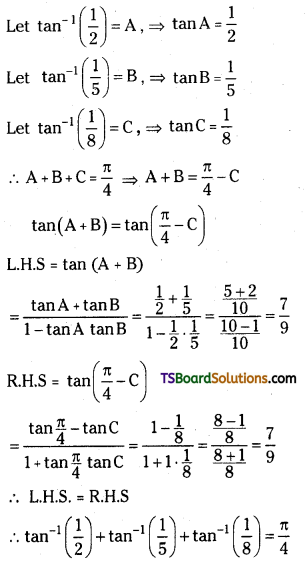
![]()
Question 7.
Find the value of tan(cos-1\(\frac{4}{5}\) + tan-1\(\frac{2}{3}\)). [Mar. ’12]
Answer:
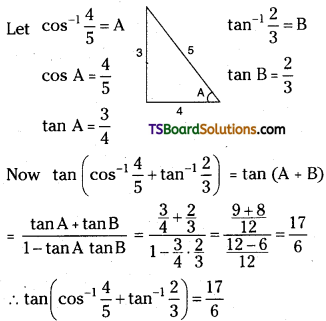
Question 8.
Prove that 2sin-1\(\left(\frac{3}{5}\right)\) – cos-1\(\left(\frac{5}{13}\right)\) = cos-1\(\left(\frac{323}{325}\right)\). [May, ’14; Mar. ’14, ’08]
Answer:
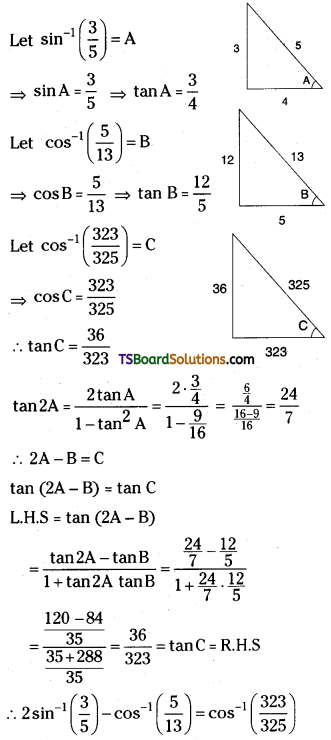
Question 9.
Prove that sin-1\(\frac{4}{5}\) + 2tan-1\(\frac{1}{3}\) = \(\frac{\pi}{2}\). [Mar. ’10, Mar. ’15(TS)]
Answer:
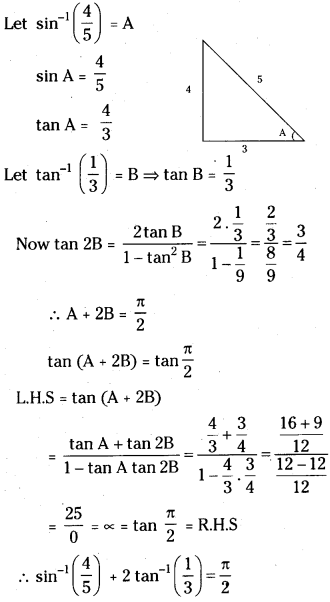
Question 10.
Show that cot (sin-1\(\sqrt{\frac{13}{17}}\)) = sin(tan-1\(\left(\frac{2}{3}\right)\))). [Mar. ’17(TS); May ’97]
Answer:
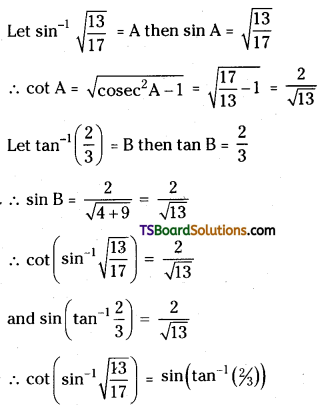
Question 11.
Prove that
cos(2stan-1\(\frac{1}{7}\)) = sin(3tan-1\(\frac{3}{4}\)). [B.P]
Answer:
L.H.S = cos(2stan-1\(\frac{1}{7}\))
Let tan-1\(\frac{1}{7}\) = A
⇒ tan A = \(\frac{1}{7}\)
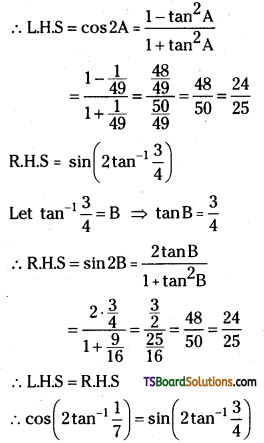
Question 12.
Prove that [Mar. ’04]
sin[cot-1\(\left(\frac{2 x}{1-x^2}\right)\) + cos-1\(\left(\frac{1-x^2}{1+x^2}\right)\)] = 1
Answer:
Put x = tan θ then
= sin[cot-1\(\left(\frac{2 \tan \theta}{1-\tan ^2 \theta}\right)\) + cos-1\(\left(\frac{1-\tan ^2 \theta}{1+\tan ^2 \theta}\right)\)]
= sin[cot-1(tan 2θ) + cos-1(cos 2θ)]
= sin[cot-1(cot(\(\frac{\pi}{2}\) – 2θ)) + cos-1(cos 2θ)]
= sin[\(\frac{\pi}{2}\) – 2θ + 2θ] = sin\(\frac{\pi}{2}\) = 1 = R.H.S
Question 13.
If cos-1p + cos-1q + cos-1r = π then prove that p2 + q2 + r2 + 2pqr = 1. [Mar ’04; Mar. ’01, ’99]
Answer:
Given cos-1p + cos-1q + cos-1r = π
Let cos-1p = A ⇒ cos A = p
Let cos-1q = B ⇒ cos B = q
Let cos-1r = C ⇒ cos C = r
A + B + C = π ⇒ A + B = π – C
cos(A + B) = cos (π – C)
⇒ cos A. cos B – sin A . sin B = – cos C
cos A cos B – \(\sqrt{1-\cos ^2 \mathrm{~A}} \cdot \sqrt{1-\cos ^2 \mathrm{~B}}\) = -cos C
pq – \(\sqrt{1-p^2} \sqrt{1-q^2}\) = -r
pq + r = \(\sqrt{1-p^2} \sqrt{1-q^2}\)
Squaring on both sides
(pq + r)2 = (1 – p2)(1 – q2)
p2q2 + r2 + 2pqr = 1 – q2 – p2 + p2q2
∴ p2 + q2 + r2 + 2pqr = 1.
![]()
Question 14.
If sin-1\(\left(\frac{2 p}{1+p^2}\right)\) – cos-1\(\left(\frac{1-q^2}{1+q^2}\right)\) = tan-1\(\left(\frac{2 x}{1-x^2}\right)\) then prove that x = \(\frac{\mathbf{p}-\mathbf{q}}{1+\mathbf{p q}}\). [May ’98]
Answer:
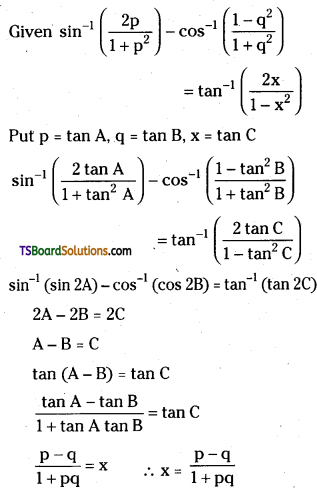
Question 15.
If sin-1x + sin-1y + sin-1z = π, then prove that x\(\sqrt{1-x^2}\) + y\(\sqrt{1-y^2}\) + z\(\sqrt{1-z^2}\) = 2xyz. [Mar. ’06; May ’05, ’97]
Answer:
Given sin-1x + sin-1y + sin-1z = π
Let sin-1x = A ⇒ sin A = x
sin-1y = B ⇒ sin B = y
sin-1z = C ⇒ sin C = z
∴ A + B + C = π
= 2sin\(\left(\frac{2 \mathrm{~A}+2 \mathrm{~B}}{2}\right)\) cos\(\left(\frac{2 \mathrm{~A}-2 \mathrm{~B}}{2}\right)\) + sin 2C
= 2 sin (A + B) cos (A – B) + sin 2C
= 2 sin (π – C) cos (A – B) + sin 2C
= 2 sin C cos (A – B) + 2 sin C cos C
= 2 sin C [cos (A – B) + cos C]
= 2 sin C [cos(A – B) + cos (π – (A + B))]
= 2 sin C [cos (A – B) – cos (A + B)]
= 2 sin C (2 sin A. sin B)
= 4 sin A sin B sin C
∴ sin 2A + sin 2B + sin 2C = 4 sin A sin B sin C
⇒ 2 sin A cos A + 2 sin B cos B + 2 sin C cos C = 4 sin A sin B sin C
⇒ sin A cos A + sin B cos B + sin C cos C = 2 sin A sin B sin C
⇒ sin\(\sqrt{1-\sin ^2 \mathrm{~A}}\) + sin B\(\sqrt{1-\sin ^2 \mathrm{~B}}\) + sin C\(\sqrt{1-\sin ^2 \mathrm{~C}}\) = 2sin A sin B sin C
∴ x\(\sqrt{1-x^2}\) + y\(\sqrt{1-y^2}\) + z\(\sqrt{1-z^2}\) = 2xyz
Question 16.
If tan-1x + tan-1y + tan-1z = π, then prove that x + y + z = xyz. [Mar. ’03]
Answer:
Given tan-1x + tan-1y + tan-1z = π
Let tan-1x = A ⇒ tan A = x
Let tan-1y = B ⇒ tan B = y
Let tan-1z = C ⇒ tan B = y
∴ A + B + C = π ⇒ A + B = π – C
tan (A + B) = tan(π – C) ⇒ \(\frac{\tan A+\tan B}{1-\tan A \tan B}\)
= -tan C
\(\frac{x+y}{1-x y}\) = -z ⇒ x + y = -z + xyz
∴ x + y + z = xyz
Question 17.
Solve tan-1\(\left(\frac{x-1}{x-2}\right)\) + tan-1\(\left(\frac{x+1}{x+2}\right)=\frac{\pi}{4}\).
Answer:
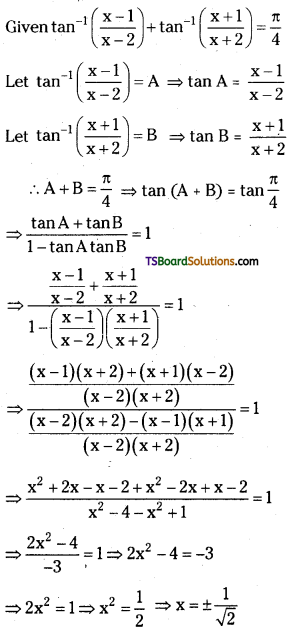
Question 18.
Solve 3sin-1\(\left(\frac{2 x}{1+x^2}\right)\) – 4cos-1\(\left(\frac{1-x^2}{1+x^2}\right)\) + 2tan-1\(\left(\frac{2 x}{1-x^2}\right)=\frac{\pi}{3}\). [Mar. ’09]
Answer:
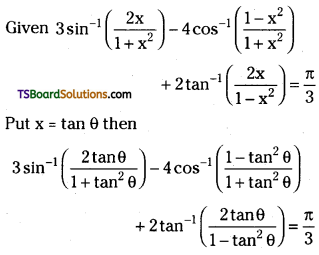
3sin-1(sin 2θ) – 4cos-1(cos 2θ) + 2tan-1(tan 2θ) = \(\frac{\pi}{3}\)
3(2θ) – 4(2θ) + 2(2θ) = \(\frac{\pi}{3}\)
⇒ 6θ – 8θ + 4θ = \(\frac{\pi}{3}\)
2θ = \(\frac{\pi}{3}\) ⇒ θ = \(\frac{\pi}{6}\)
⇒ tan θ = tan \(\frac{\pi}{6}\)
∴ x = \(\frac{1}{\sqrt{3}}\)
![]()
Some More Maths 1A Inverse Trigonometric Functions Important Questions
Question 1.
Prove that sin-1\(\left(\frac{4}{5}\right)\) + sin-1\(\left(\frac{5}{13}\right)\) + sin-1\(\left(\frac{16}{65}\right)=\frac{\pi}{2}\). [Mar ’18(AP)]
Answer:
Let sin-1\(\left(\frac{4}{5}\right)\) = A and sin-1\(\left(\frac{5}{13}\right)\) = B
∴ sin A = \(\frac{4}{5}\) and sin B = \(\frac{5}{13}\)
∴ cos A = \(\frac{3}{5}\) and cos B = \(\frac{12}{13}\)
Also cos (α + β) = cos α cos β – sin α sin β
= \(\frac{3}{5} \cdot \frac{12}{13}-\frac{4}{5} \cdot \frac{5}{13}=\frac{16}{65}\)
∴ α + β = cos-1\(\left(\frac{16}{65}\right)\) ⇒ sin-1\(\left(\frac{4}{5}\right)\) + sin-1\(\left(\frac{5}{13}\right)\) = cos-1\(\left(\frac{16}{65}\right)\)
L.H.S = sin-1\(\left(\frac{4}{5}\right)\) + sin-1\(\left(\frac{5}{13}\right)\) + sin-1\(\left(\frac{16}{65}\right)\) = cos-1\(\left(\frac{16}{65}\right)\) + sin-1\(\left(\frac{16}{65}\right)\) = \(\frac{\pi}{2}\)
Question 2.
Prove that cot-19 + cosec-1\(\frac{\sqrt{41}}{4}=\frac{\pi}{4}\).
Answer:
Let cot-19 = α
Let cosec-1\(\frac{\sqrt{41}}{4}\) = β
⇒ cot α = 9 ⇒ cosec β = \(\frac{\sqrt{41}}{4}\)
⇒ tan α = \(\frac{1}{9}\) ⇒ tan β = \(\frac{4}{5}\)
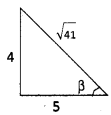
From the figure
Take tan (α + β) = \(\frac{\tan \alpha+\tan \beta}{1-\tan \alpha \cdot \tan \beta}\)
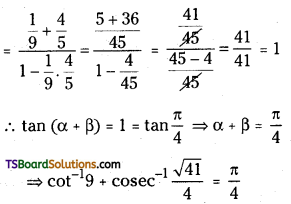
Question 3.
Prove that sin-1\(\left(\frac{4}{5}\right)\) + 2tan-1\(\left(\frac{1}{3}\right)=\frac{\pi}{2}\)
Answer:
Let sin-1\(\left(\frac{4}{5}\right)\) = A then sin A = \(\frac{4}{5}\) and
tan-1\(\left(\frac{1}{3}\right)\) = B then tan B = \(\frac{1}{3}\)
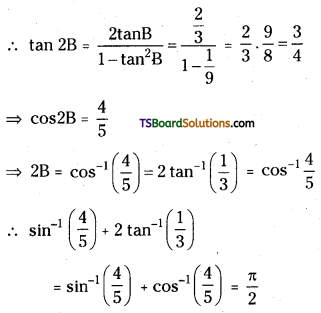
![]()
Question 4.
If cos-1\(\frac{p}{a}\) + cos-1\(\frac{q}{b}\) = α, then prove that \(\frac{p^2}{a^2}-\frac{2 p q}{a b}\)cos α + \(\frac{q^2}{b^2}\) = sin2α
Answer:
Given cos-1\(\frac{p}{a}\) + cos-1\(\frac{q}{b}\) = α
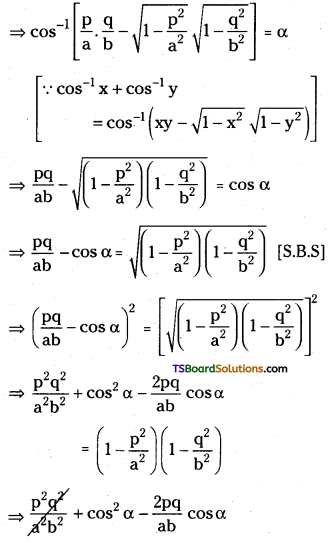
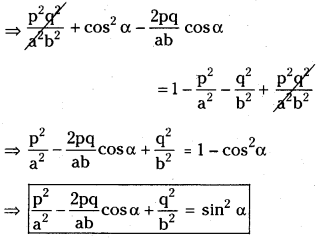
Question 5.
Solve sin-1\(\left(\frac{5}{x}\right)\) + sin-1\(\left(\frac{12}{x}\right)=\frac{\pi}{2}\), (x > 0)
Answer:
Let sin-1\(\left(\frac{5}{x}\right)\) = A and sin-1\(\left(\frac{12}{x}\right)\) = B then
sin A = \(\frac{5}{x}\) and sin B = \(\frac{12}{x}\)(x > 0)
∴ Now α + β = \(\frac{\pi}{2}\) ⇒ sin α = sin(\(\frac{\pi}{2}\) – β)
= cos β ⇒ \(\frac{5}{x}=\sqrt{1-\frac{144}{x^2}}\)
⇒ \(\frac{25}{x^2}=1-\frac{144}{x^2} \Rightarrow \frac{169}{x^2}\) = 1 ⇒ x2 = 169
⇒ x = ±13 But x = 13(∵ x > 0)
Question 6.
Prove that sin-1\(\left(\frac{3}{5}\right)\) + cos-1\(\left(\frac{12}{13}\right)\) = cos-1\(\left(\frac{33}{65}\right)\).
Answer:
Let sin-1\(\left(\frac{3}{5}\right)\) = A and cos-1\(\left(\frac{12}{13}\right)\) = B then
A + B ∈ (0, π)
∴ sin A = \(\frac{3}{5}\) and cos B = \(\frac{12}{13}\)
cos A = \(\frac{4}{5}\) and sin B = \(\frac{5}{13}\)
Consider cos(A + B) = cos A cos B – sin A sin B
= \(\left(\frac{4}{5}\right)\left(\frac{12}{13}\right)-\left(\frac{3}{5}\right)\left(\frac{5}{13}\right)=\frac{48}{65}-\frac{15}{65}=\frac{33}{65}\)
A + B = cos-1\(\left(\frac{33}{65}\right)\)
⇒ sin-1\(\left(\frac{3}{5}\right)\) + cos-1\(\left(\frac{12}{13}\right)\) = cos-1\(\left(\frac{33}{65}\right)\)
Question 7.
Find the values of sin(cos-1\(\frac{3}{5}\) + cos-1\(\frac{12}{13}\)).
Answer:
Let cos-1\(\left(\frac{3}{5}\right)\) = A and cos-1\(\left(\frac{12}{13}\right)\) = B then
cos A = \(\frac{3}{5}\) and cos B = \(\frac{12}{13}\)
∴ sin A = \(\frac{4}{5}\) and sin B = \(\frac{5}{13}\)
∴ sin(A + B) = sin A cos B + cos A sin B
= \(\left(\frac{4}{5}\right)\left(\frac{12}{13}\right)+\left(\frac{3}{5}\right)\left(\frac{5}{13}\right)=\frac{63}{65}\)
∴ sin(cos-1\(\frac{3}{5}\) + cos-1\(\frac{12}{13}\))
Question 8.
Prove that cos(2tan-1\(\frac{1}{7}\)) = sin(2tan-1\(\frac{3}{4}\))
Answer:
Let α = tan-1(\(\frac{1}{7}\)) then tan α = \(\frac{1}{7}\)
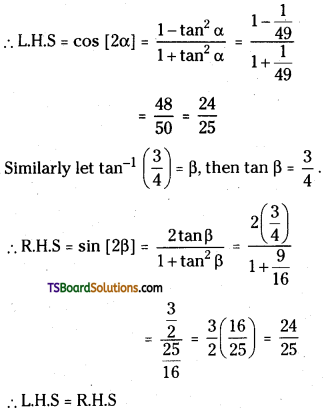
![]()
Question 9.
Prove that tan-1\(\frac{1}{7}\) + tan-1\(\frac{1}{13}\) – tan-1\(\frac{2}{9}\) = 0
Answer:
L.H.S = (tan-1\(\frac{1}{7}\) + tan-1\(\frac{1}{13}\)) – tan-1\(\frac{2}{9}\)
[we have x > 0, y > 0, xy > 1 then tan-1x + tan-1y + tan-1z = tan-1\(\left(\frac{x+y}{1-x y}\right)\)]
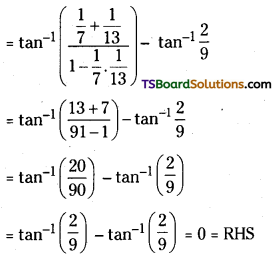
Question 10.
Prove that tan-1\(\frac{3}{4}\) + tan-1\(\frac{3}{5}\) – tan-1\(\frac{8}{19}\) = \(\frac{\pi}{4}\)
Answer:
LHS = tan-1\(\frac{3}{4}\) + tan-1\(\frac{3}{5}\) – tan-1\(\frac{8}{19}\)
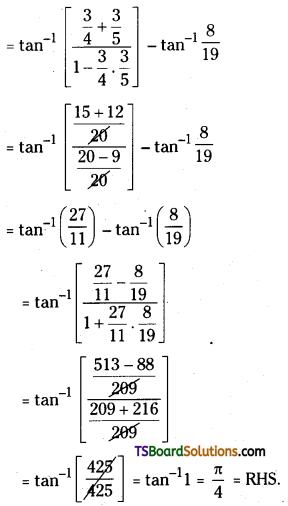
Question 11.
Show that tan-1\(\frac{1}{7}\) + tan-1\(\frac{1}{8}\) = cot-1\(\frac{201}{43}\) + cot-118.
Answer:
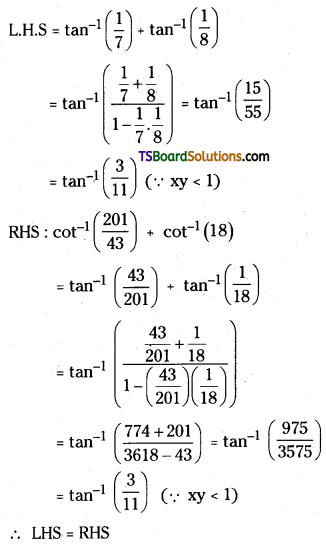
Question 12.
Show that sec2 (tan-12) + cosec2 (cot-12) = 10.
Answer:
Let a = tan-12 ⇒ tan α = 2
sec2α = 1 + tan2α = 1 + 4 = 5
Let β = cot-12 ⇒ cot β = 2
∴ cosec2β = 1 + cot2β = 1 + 4 = 5
∴ sec2 (tan-12) + cosec2 (cot-12)
= sec2α + cosec2β = 5 + 5 = 10
![]()
Question 13.
If α = tan-1\(\left[\frac{\sqrt{1+x^2}-\sqrt{1-x^2}}{\sqrt{1+x^2}+\sqrt{1-x^2}}\right]\), then prove that x2 = sin 2α.
Answer:

Question 14.
If tan-1x + tan-1y + tan-1z = \(\frac{\pi}{2}\), prove that xy + yz + zx = 1.
Answer:
Given tan-1x + tan-1y + tan-1z = \(\frac{\pi}{2}\)
tan-1x + tan-1y = \(\frac{\pi}{2}\) – tan-1z
tan-1\(\left[\frac{x+y}{1-x y}\right]\) = \(\frac{\pi}{2}\) – tan-1z
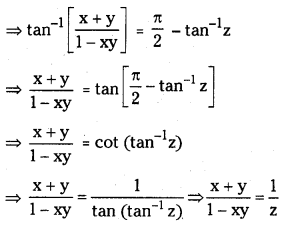
⇒ (x + y)z = 1 – xy
⇒ xz + yz = 1 – xy
⇒ xy + yz + zx = 1